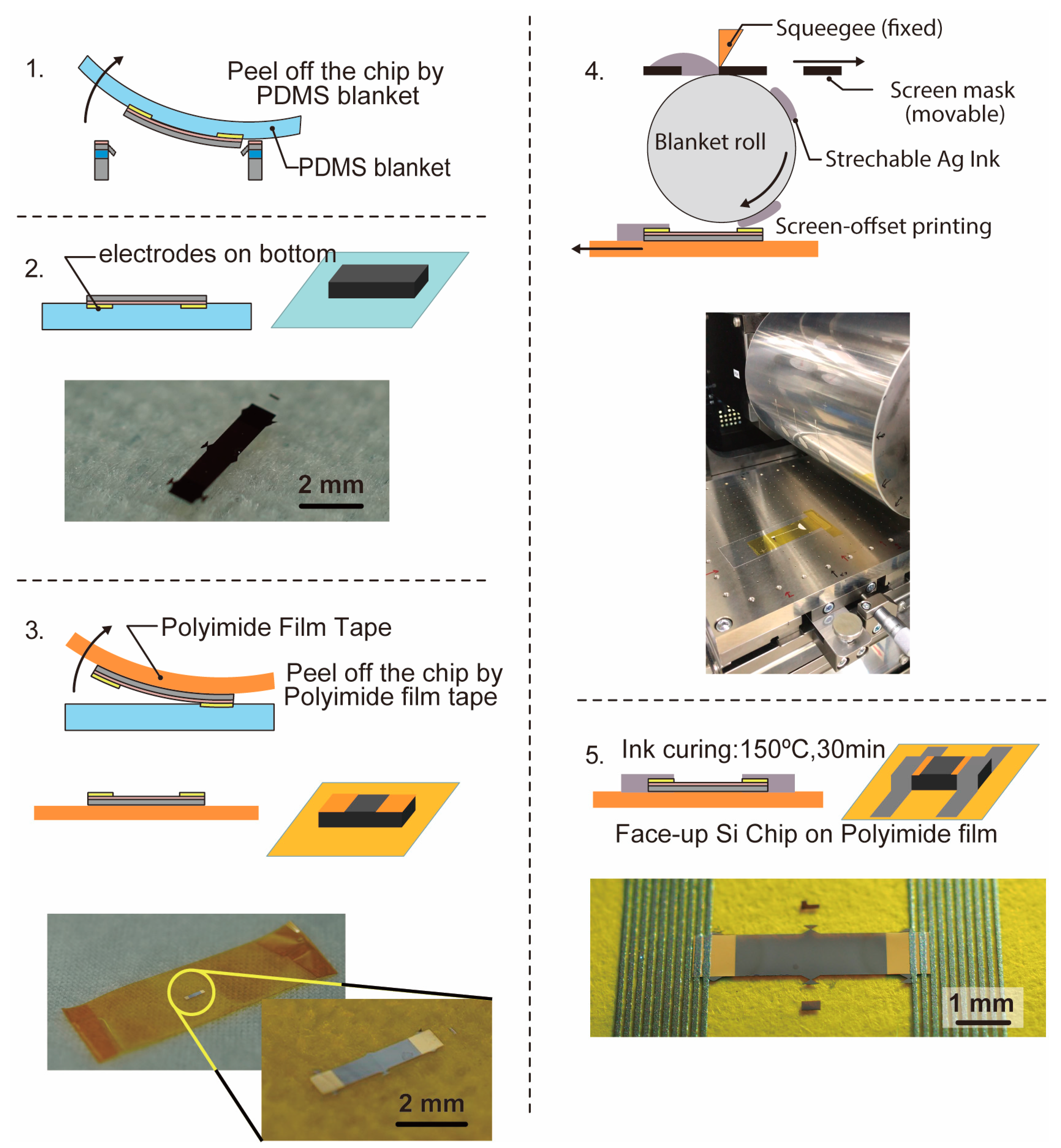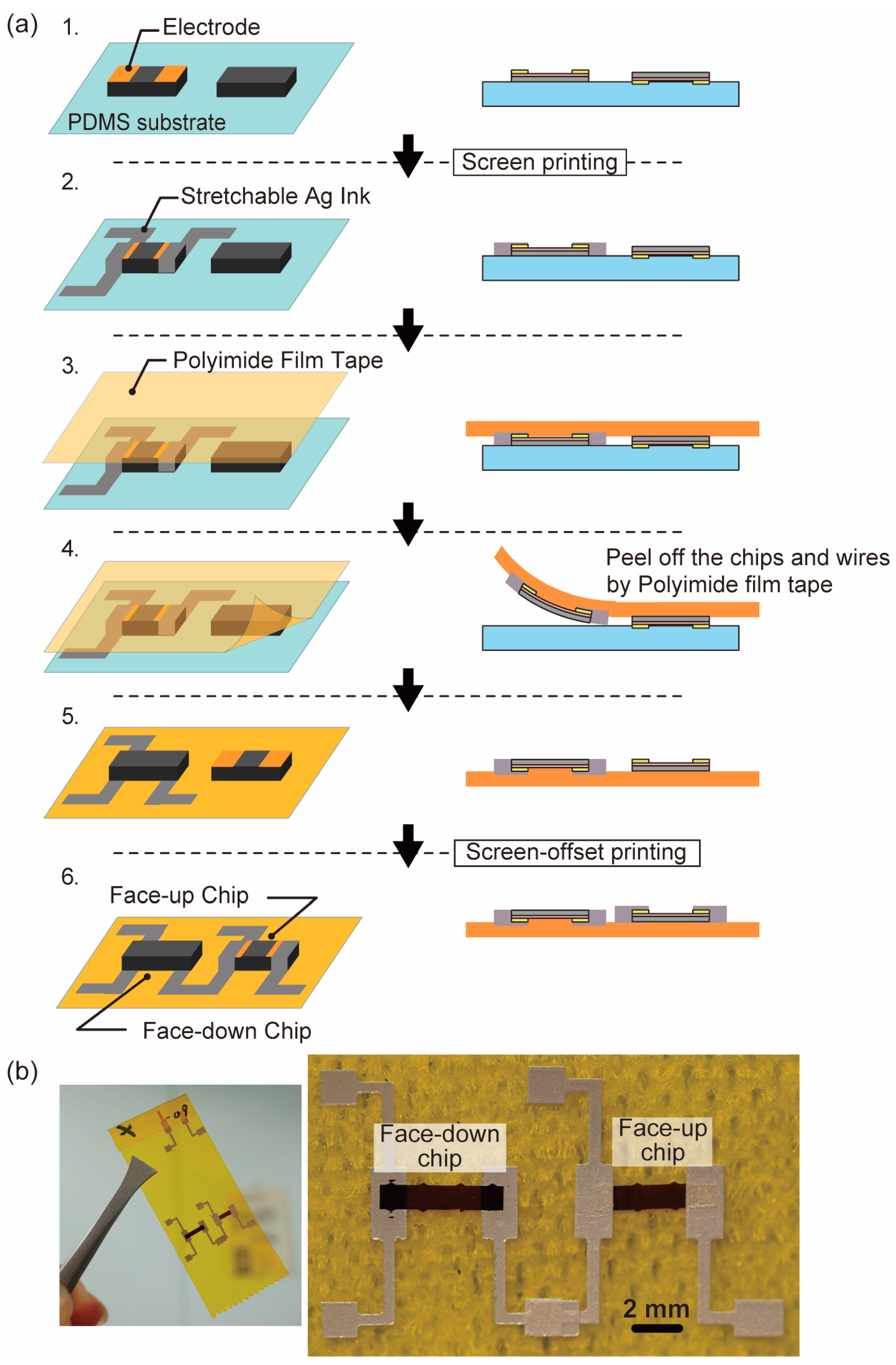Fabrication of Simultaneously Implementing “Wired Face-Up and Face-Down Ultrathin Piezoresistive Si Chips” on a Film Substrate by Screen-Offset Printing
Abstract
:1. Introduction
2. Fabrication
2.1. Chip Implementation Using Screen-Offset Printing
2.2. Fabrication of Ultrathin Face-Up/Face-Down Chip
2.3. Implementing Process for Face-Up chip
2.4. Implementing Process for Face-Down Chip
2.5. Implementing Process for a Mixture of Face-Up and Face-Down Chip
3. Film-Type Blood Pulse Sensor Demonstration
4. Conclusions
Author Contributions
Funding
Conflicts of Interest
References
- Chaney, R.L.; Leber, D.E.; Hackler, D.R.; Meek, B.N.; Leija, S.D.; DeGregorio, K.J.; Wald, S.F.; Wilson, D.G. Advances in flexible hybrid electronics reliability. In Proceedings of the 2017 IEEE Workshop on Microelectronics and Electron Devices (WMED), Boise, ID, USA, 21 April 2017; pp. 5–8. [Google Scholar]
- Harendt, C.; Kostelnik, J.; Kugler, A.; Lorenz, E.; Saller, S.; Schreivogel, A.; Yu, Z.L.; Burghartz, J.N. Hybrid systems in foil (hysif) exploiting ultra-thin flexible chips. Solid-State Electron. 2015, 113, 101–108. [Google Scholar] [CrossRef]
- Herbert, R.; Kim, J.H.; Kim, Y.S.; Lee, H.M.; Yeo, W.H. Soft material-enabled, flexible hybrid electronics for medicine, healthcare, and human-machine interfaces. Materials 2018, 11, 187. [Google Scholar] [CrossRef] [PubMed]
- Huang, T.C.; Marsh, J.; Goodwin, S.H.; Temple, D.S. Innovative practices on design & test for flexible hybrid electronics. In Proceedings of the 2018 IEEE 36th VLSI Test Symposium (VTS), San Francisco, CA, USA, 22–25 April 2018; p. 1. [Google Scholar]
- Kim, D.H.; Yoo, H.G.; Hong, S.M.; Jang, B.; Park, D.Y.; Joe, D.J.; Kim, J.H.; Lee, K.J. Simultaneous roll transfer and interconnection of flexible silicon nand flash memory. Adv. Mater. 2016, 28, 8371–8378. [Google Scholar] [CrossRef] [PubMed]
- Leever, B.; Durstock, M.; Tabor, C.; Berrigan, J.; Juhl, A. Development of Flexible Hybrid Electronics Materials and Processes for Air Force Applications; Abatracts of Papers of The American Chemical Society: Washington, DC, USA, 2015; p. 250. [Google Scholar]
- Pal, L.; Joyce, M. Paper need not be flat: Paper and biomaterials industries need to converge to bring about true innovation. Bioresources 2017, 12, 2249–2251. [Google Scholar] [CrossRef]
- Shahrjerdi, D.; Bedell, S.W.; Khakifirooz, A.; Cheng, K. Mechanically flexible nanoscale silicon integrated circuits powered by photovoltaic energy harvesters. Solid-State Electron. 2016, 117, 117–122. [Google Scholar] [CrossRef]
- Takeshita, T.; Yamashita, T.; Makimoto, N.; Kobayashi, T. Development of ultra-thin MEMS micro mirror device. In Proceedings of the 2017 19th International Conference on Solid-State Sensors, Actuators and Microsystems (Transducers), Kaohsiung, Taiwan, 18–22 June 2017; pp. 2143–2146. [Google Scholar]
- Brand, J.v.d.; Kok, M.d.; Koetse, M.; Cauwe, M.; Verplancke, R.; Bossuyt, F.; Jablonski, M.; Vanfleteren, J. Flexible and stretchable electronics for wearable health devices. Solid-State Electron. 2015, 113, 116–120. [Google Scholar] [CrossRef]
- Khan, Y.; Garg, M.; Gui, Q.; Schadt, M.; Gaikwad, A.; Han, D.G.; Yamamoto, N.A.D.; Hart, P.; Welte, R.; Wilson, W.; et al. Flexible hybrid electronics: Direct interfacing of soft and hard electronics for wearable health monitoring. Adv. Funct. Mater. 2016, 26, 8764–8775. [Google Scholar] [CrossRef]
- Mousoulis, C.; Jiang, X.F.; Raghunathan, N.; Peroulis, D. A hybrid, networked, wireless system for humidity sensing. In Proceedings of the 2017 IEEE Sensors, Scotland, UK, 30 October–1 November 2017; pp. 927–929. [Google Scholar]
- Park, J.; Joshi, H.; Lee, H.G.; Kiaei, S.; Ogras, U.Y. Flexible pv-cell modeling for energy harvesting in wearable IoT applications. ACM Trans. Embedded Comput. Syst. 2017, 16, 156. [Google Scholar] [CrossRef]
- Poliks, M.; Turner, J.; Ghose, K.; Jin, Z.P.; Garg, M.; Gui, Q.; Arias, A.; Kahn, Y.; Schadt, M.; Egitto, F. A wearable flexible hybrid electronics ECG monitor. In Proceedings of the 2016 IEEE 66th Electronic Components and Technology Conference (ECTC), Las Vegas, NV, USA, 31 May–3 June 2016; pp. 1623–1631. [Google Scholar]
- Nomura, K.; Horii, Y.; Kanazawa, S.; Kusaka, Y.; Ushijima, H. Fabrication of a textile-based wearable blood leakage sensor using screen-offset printing. Sensors 2018, 18, 240. [Google Scholar] [CrossRef] [PubMed]
- Nomura, K.; Kaji, R.; Iwata, S.; Otao, S.; Imawaka, N.; Yoshino, K.; Mitsui, R.; Sato, J.; Takahashi, S.; Nakajima, S.; et al. A flexible proximity sensor formed by duplex screen/screen-offset printing and its application to non-contact detection of human breathing. Sci. Rep. 2016, 6, 19947. [Google Scholar] [CrossRef] [PubMed] [Green Version]
- Nomura, K.; Kusaka, Y.; Ushijima, H.; Nagase, K.; Ikedo, H.; Mitsui, R.; Takahashi, S.; Nakajima, S.; Iwata, S. Continuous fine pattern formation by screen-offset printing using a silicone blanket. J. Micromech. Microeng. 2014, 24, 095021. [Google Scholar] [CrossRef]
- Nomura, K.; Ushijima, H.; Nagase, K.; Ikedo, H.; Mitsui, R.; Sato, J.; Takahashi, S.; Nakajima, S.; Arai, M.; Kurata, Y.; et al. Simultaneous formation of fine and large-area electrode patterns using screen-offset printing and its application to the patterning on adhesive materials. Jpn. J. Appl. Phys. 2016, 55, 03DD01. [Google Scholar] [CrossRef]
- Nomura, K.; Ushijima, H.; Mitsui, R.; Takahashi, S.; Nakajima, S. Screen-offset printing for fine conductive patterns. Microelectron. Eng. 2014, 123, 58–61. [Google Scholar] [CrossRef]
- Takei, Y.; Goto, S.; Takamatsu, S.; Itoh, T.; Kobayashi, T. Flexible contact pressure sensor based on ultrathin piezoresistive silicon membrane capable of strain compensation. Sens. Mater. 2018, 30, 2999–3007. [Google Scholar] [CrossRef]








© 2019 by the authors. Licensee MDPI, Basel, Switzerland. This article is an open access article distributed under the terms and conditions of the Creative Commons Attribution (CC BY) license (http://creativecommons.org/licenses/by/4.0/).
Share and Cite
Takei, Y.; Nomura, K.-i.; Horii, Y.; Zymelka, D.; Ushijima, H.; Kobayashi, T. Fabrication of Simultaneously Implementing “Wired Face-Up and Face-Down Ultrathin Piezoresistive Si Chips” on a Film Substrate by Screen-Offset Printing. Micromachines 2019, 10, 563. https://doi.org/10.3390/mi10090563
Takei Y, Nomura K-i, Horii Y, Zymelka D, Ushijima H, Kobayashi T. Fabrication of Simultaneously Implementing “Wired Face-Up and Face-Down Ultrathin Piezoresistive Si Chips” on a Film Substrate by Screen-Offset Printing. Micromachines. 2019; 10(9):563. https://doi.org/10.3390/mi10090563
Chicago/Turabian StyleTakei, Yusuke, Ken-ichi Nomura, Yoshinori Horii, Daniel Zymelka, Hirobumi Ushijima, and Takeshi Kobayashi. 2019. "Fabrication of Simultaneously Implementing “Wired Face-Up and Face-Down Ultrathin Piezoresistive Si Chips” on a Film Substrate by Screen-Offset Printing" Micromachines 10, no. 9: 563. https://doi.org/10.3390/mi10090563




